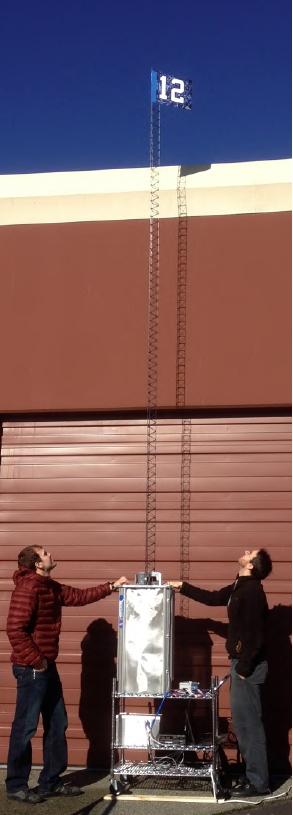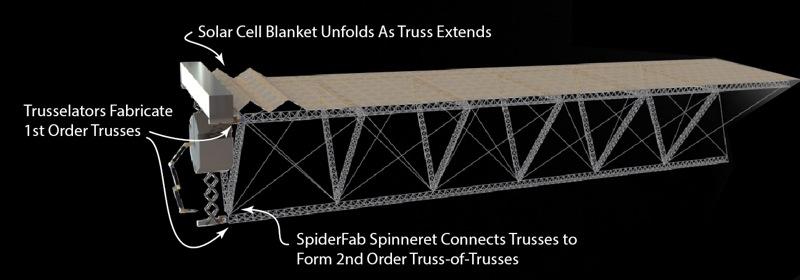The Trusselator is aimed at creating, through the use of in-space additive manufacturing, a series of high-performance trusses to handle large solar arrays and antennas, and NASA says Tethers Unlimited has been awarded $750,000 to continue development of the technology.
 The funds will come from the NASA Innovative Advanced Concepts (NIAC) program and the NASA Small Business Innovative Research (SBIR) program.
The funds will come from the NASA Innovative Advanced Concepts (NIAC) program and the NASA Small Business Innovative Research (SBIR) program.
It’s all part of a group of ideas Tethers Unlimited Inc. (TUI) is developing under the umbrella of their SpiderFab project, a plan to fabricate spacecraft components in Earth orbit.
The architecture of the project integrates elements of 3D printing, automated composite layup, and robotic assembly to build large, lightweight structures to support solar cells and reflectors.
It’s not small thinking as the various elements will be used to create antennas and solar arrays the size of a sports stadium.
The companies hope to solve a major problem with space travel: how developers can manufacture affordable space systems larger than those which can be built on the Earth and then launched inside a rocket.
“Developing the Trusselator device is the key first step in implementing the SpiderFab capability for in-space manufacturing,” says Dr. Robert Hoyt, CEO and Chief Scientist at TUI. “Our goal with this effort is to dramatically reduce the costs of building large systems in space. In the new SBIR effort, we will develop a prototype Trusselator designed to operate in the vacuum environment of space and test it in our new space simulation facility.”
Over the long haul, Hoyt says the idea of manufacturing spacecraft components in orbit will one day prove critical to projects like a manned missions to Mars.
The companies say the technology could also be used to create solar sails of enormous size, antennas for high-bandwidth communications, and masts many kilometers long for interferometric astronomy projects.
It all comes down to making improvements in packing efficiency and launch mass, and Phase I of the Trusselator effort has already demonstrated that fabrication of continuous lengths of high-performance carbon fiber truss, using a novel additive manufacturing process, have superior bending stiffness efficiency when compared to existing deployable mast technologies.
The company says Phase II of the effort will take on the the key technical risks and further develop the process by refining the additive manufacturing process elements the truss products, and then work on design and prototype elements of a “Trusselator” which can work in the “thermal-vacuum environment” of space. Do you think you’ll live to see the day when additive manufacturing processes are used to create huge projects in space? Let us know what you think in the Trusselator thread on 3DPB.com.
Subscribe to Our Email Newsletter
Stay up-to-date on all the latest news from the 3D printing industry and receive information and offers from third party vendors.
You May Also Like
Air Force Awards Fortius Metals $1.25M to Qualify 3D Printing Wire for Hypersonic Applications
AFWERX, part of the US Air Force Research Laboratory (AFRL), awarded a Direct-to-Phase II Small Business Innovation Research (SBIR) contract worth $1.25 million to Colorado’s Fortius Metals, to accelerate qualification...
US Air Force Awards JuggerBot $4M for Large-format Hybrid 3D Printing
Large-format 3D printer manufacturer JuggerBot has received a $4 million grant to develop a large format 3D printer, courtesy of the Under Secretary of Defense, Research and Engineering Manufacturing Technology...
Where Have All AM’s Unicorns Gone?
In the rapidly evolving world of 3D printing, startups valued at over a billion dollars, known as unicorns, once seemed as fantastical as the mythical creatures themselves. While a few...
How My Childhood Fascination with Planes Led to Investing in 3D Printing
My fascination with aerospace started young, and I started studying planes–identifying them in the sky and learning everything I could about how they work. Fast forward to my first week...

































